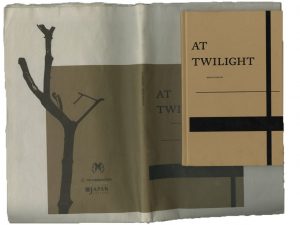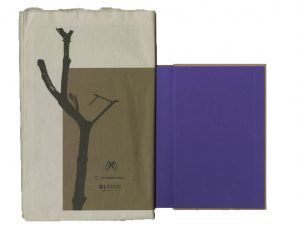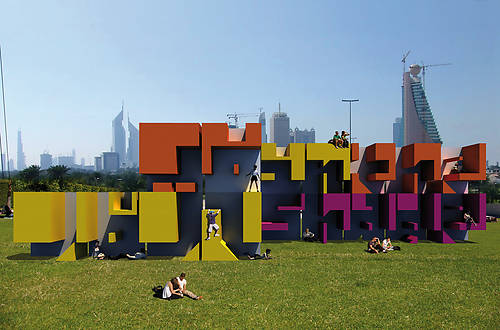By reading an interview about Åbäke, a design collective of four, I found out that they decided to work together using one name, one emailadress, one bank account and one invoicing system. The group started in 2000 and at that time they always worked together on their projects. Nowadays they’re working more individually as “It seemed that only working within the four of us was leading to implosion”. I find this promise that they made very beautiful and intriguing, since I personally think it’s very unusual and brave to commit to each other like this. Because it’s so unusual, it also raised a lot of questions.
After reading this interview I wrote the following text about my thoughts around the decisions they made. I asked Åbäke to read it and to cross out certain statements that they don’t agree with and questions that would have a negative answer, those are marked red. Logically, the green stands for positive answers and agreement. I would advise you to read the interview before continuing reading.
The construct Åbäke made (sharing name, money) is really similar to the essence of marriage. People mostly marry out of love and therefore they feel the need to share (name and property) and promise each other (financial) support unconditionally. Even though the idea of marriage got romanticized, the foundation is really practical and pragmatical. But, the main goal of it is to become happy together forever. When it comes to work though, I’ve learnt that the main goal is to become successful. I wonder, did Åbäke become a group just because they liked to be together? Or to become successful? Most probably a combination.
If the reason would be success, would this need to be a group also state the presence of insecurities of one’s own abilities? If so, is that necessarily a bad thing? Or is forming a group actually proof of self-knowledge and honesty?
In this specific interview it’s really clear to me that being successful for Åbäke doesn’t necessarily means earning a lot of money, having a lot of free time next to work or becoming famous, it’s mostly being able to develop great work.
For myself and with me many others, I believe that I have the same goal, but I’ve learnt that the way to measure the “greatness” of a work is simply by the reward. In a way money or acknowledgement do translate back to me how much effort or work is worth. That’s also a reason why I find this promise so fascinating. Do you gain or lose acknowledgement when you share a name? Does it feels as nice to be acknowledged for a work someone else made under the same name as it does when you’ve made something on your own? Would it be more rewarding to receive money straight away to your bank account? So you can measure for each project separately what kind of work you delivered. Or does it work the other way around? That by getting the same amount paid every month, no performance seems worth less or more than the other.
Now that I write this I also realize a part in the interview about how interesting projects pay less than boring ones. Maybe that’s the reason to not even choose money as a way to measure achievements, since it’s apparently not that reliable.
But then there’s still the shared name. Although I think I’m understanding it more and more while writing this, I still don’t think I would be able to share my artist name with my boyfriend for example. Even though I would marry him if he’d ask, share everything together, both using the same name feels like I’m giving up a part of myself. I think it could have a lot to do with pride as well, and that’s mainly because of the creative part.
For example, if I would work as a waitress in a restaurant, I would also make a commitment to my boss, under specific terms and conditions. But, in this situation there’s a hierarchy; I’m working in the name of my boss, following his rules, not out of my own ideas. Everyone visiting the restaurant is also aware of that the way I work isn’t out of me as a person, but me fulfilling my boss’s expectations.
When working creatively though, the whole point is ideas being executed by this one exact person. The maker is crucial when it comes to creativity since that’s the person that creates the outcome. You could say that the work is carrying the makers identity. And aren’t we all proud of our identity? So what happens with your identity when you share it with multiple people? Does it gets lost? Or does it become even bigger/better? Is it even possible to identify an identity in a name at all? And if so, what happens then with this pride when you share a name? Is this identity actually as important as I just stated? Or is it just a way for artists to cover up their ego’s? Is it my ego that makes me hesitant to even thinking of sharing my name?
And when you’d look less into the emotional side of it, but more to the actual working process, does it releases work pressure to share a name? Or does the responsibility of others makes you work even harder?
I would also like to get back to this implosion they mentioned before in the interview. Something implodes when the pressure from outside is higher than the pressure inside.* Would the outside in this case then mean work related expectations from outside the group? Or, would both the outside and the inside represent the group itself? And again, what is the motive to stick together after a near-implosion, is it love, loyalty, or the pursuit of success?
In any case, I personally think it’s a very admirable way of being a collective. Also I’m happy that it invited me to rethink motives, certain constructs, and being an individual. It actually made me feel disconnected from myself and the reasons why I like to be busy with art. After I had a talk with Åbäke, a lot of questions still remained. What do I want? What do I need to get there? But, I also ended up with one really good advice. – Although it can be helpful to think about these things, it can also be helpful to let go of this assume that there has to be one higher goal. A better question to ask would be, why do I like what I’m doing now? In that way a person could spent hours on finding the right curve for the letter Å. The key isn’t necessarily to strive and long for “the great” but to find joy in small things and make them as great and important as you feel like.
“Success is mostly about being able to develop great work.”
*Åbäke did point out to me that after an implosion, an explosion occurs.
AT TWILIGHT // SIMON STARLING
When our teacher was explaining us in the Rietveld library to choose a book that the library obtained last year to eventually write about the design of it, I couldn’t really focus as there was this book sticking out on the shelf of which i thought i liked the texture. I went to have a look at it. As the teacher’s voice faded, the book cover became clearer. Turned out that it didn’t look like how i thought it did, but after going through the rest of the library, I still preferred this one.
What made the book catch my eye was first of all that it was wrapped in plastic, as if it’s something really precious. And secondly it was a, I thought, white book that had brown bakery paper around it, as if it was handmade. This wasn’t the book though, and neither did it have brown bakery paper around it; I think it’s an extension of the actual book. The reason I do is because this “extension” has the form of a newspaper which makes it seem less important than the book that was also inside the plastic. Also in this newspaper there’s mostly big pictures shown, that probably aren’t the subject of the book but are there to support the context of the book.
The book itself has a very minimalist appearance, brown matte hardcover with black letters and three lines. But, when you open it, the first page is a very bright purple paper. After that, for the first half of the book it has brown paper and an often used font. Turns out it’s a play: probably the reason to choose an easy readable font and well structured text over the pages. The second half of the book has white pages and a more playful appearance. The font comes across less mature to me and also there’s a lot of pictures, even scanned in papers with written notes on it in this half of the book. I find it quite interesting how these simple choices changed the book into something special.
Simon Starling : at twilight, a play for two actors, three musicians, one dancer, eight masks (and a donkey costume). designer: Åbäke, publisher: Dent-De-Leone, Rietveld Library Cat. no: star 2






